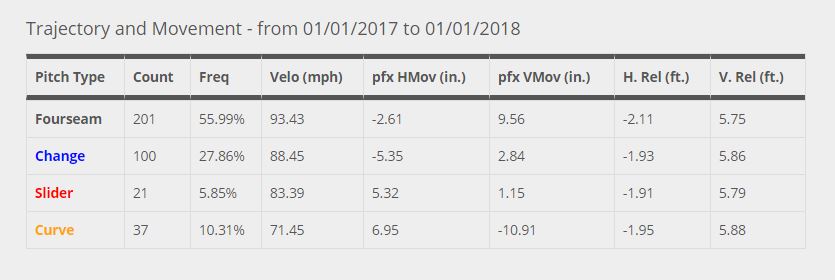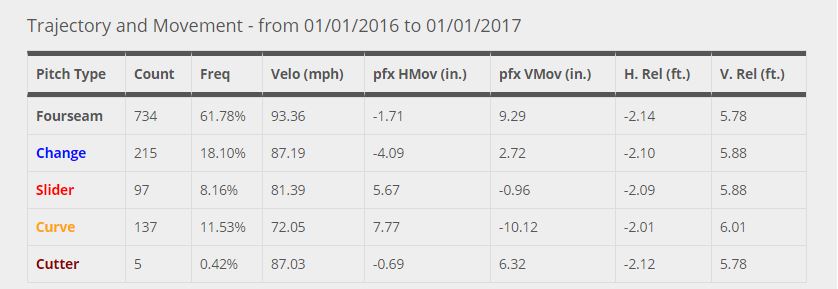Joakim Soria is good again. At least he has been to this point. In 15 appearances spanning 15.2 innings, he’s given up five runs (four earned) on 12 hits. He’s struck out an excellent 24 and walked seven. He has a 2.30 ERA, a 1.74 DRA, a 1.28 FIP and a very good number for basically any other metric you want to look toward. The seven walks is a bit high, but five came in his first five games, so maybe that’s evening out.
It’s been easy to dislike the second Joakim Soria era of Royals baseball. The team is 92-102 since he rejoined Kansas City. That was after they were 270-216 in the previous three seasons. He gave up a lot of leads in 2016. He gave up so many, in fact, that you could make an argument that he cost them a playoff spot, especially with his final 13 appearances of the year changing the result of five different games.
But 2017 is a different season. The Royals are worse by a lot, but Soria is better. By a lot.
There are three questions to ask. How? Why? Will it last?
The how is pretty simple. He’s getting more swings and misses. It isn’t a ton more, but it’s enough to make a big difference. Opponents have whiffed on 30 percent of their swings this year. That’s up from 26.5 percent last year and well above his career rate of 25 percent. His previous best whiff rate is 29.6 percent in 2009, the year he posted a 2.21 ERA and struck out 11.7 per nine innings. He seems to be doing it by relying more on a changeup that was very good last year and has continued to be good this season.
| Year | Swinging Strike Rate | K/9 |
| 2007 | 22.50% | 9.8 |
| 2008 | 26.57% | 8.8 |
| 2009 | 29.62% | 11.7 |
| 2010 | 22.65% | 9.7 |
| 2011 | 23.08% | 9.0 |
| 2013 | 24.37% | 10.6 |
| 2014 | 24.12% | 9.7 |
| 2015 | 22.48% | 8.5 |
| 2016 | 26.52% | 9.2 |
| 2017 | 31.15% | 13.8 |
You may recall last year that I talked about Soria’s slider giving him trouble. And boy, did it. Opponents hit .458 on it with a .792 slugging percentage. Righties had a slugging percentage of .826 on it, and they were the primary recipients. In general, he struggled against righties allowing a .297/.377/.555 line compared to .246/.308/.362 against lefties.
The changeup, which again was very good, was used, but not quite often enough given his results on it. Fast forward to spring training where Soria flashed the slider and it looked tighter in the few chances we had to see it. I thought that would key his turnaround.
Boy, was I wrong.
The solution was much simpler than fixing the slider. He simply took what was working last season and just did more of it. The results have been telling. See, while his slider was hit very hard, the fastball was the real problem last season. He threw it 734 times and allowed a .336 average with a .595 slugging percentage against it. He allowed line drives 23.4 percent of the time against it. The ball was getting hit hard an awful lot. He also had trouble controlling it, walking 19 batters using it. But more importantly, he gave up 15 extra base hits in just 116 at bats that ended on it. That’s a lot.
But now he’s using his changeup more. Check out the comparison in usage:
| Year | Total Use | vs. RHB | vs. LHB |
| 2017 | 27.86% | 23.27% | 33.76% |
| 2016 | 18.20% | 12.81% | 23.66% |
So he’s cut back on his slider to add to the changeup. He’s also thrown his curve a little less, which I’m fine with. It’s a fun pitch when it drops into the zone and the hitter can’t do anything with it, but it seems too risky to me in an era with hitters working to find pitches just like a big looping curve to power into the seats. And he’s cut back on his fastball ever-so slightly. Take a look at his pitch usage below.
2017
2016
Using his changeup more has helped with two things. The first is that he’s been a ground ball machine this year with a 65.6 percent ground ball rate. That’s helped him to coax three double plays this season. So that’s the easy to part. The other side of it is that the extra use is probably helping the other pitches play up. He’s increased the swing and miss on the fastball by about six percent this season. The one thing he’s been doing that can’t be explained by the changeup is that he’s been getting more horizontal movement on his fastball. There are some changes in the way data is gathered, so this may just be a blip, but it’s worth watching. His release point hasn’t changed enough to make this big of an impact. He has, however, increased his average spin rate on his fastball.
Last season, he averaged about 2,187 RPM on it. This year, he’s averaging about 2,273 RPM. That’s a pretty big increase and shows the extra movement, but if we’re wondering about its sustainability, the why might be as important as the what.
A couple theories make sense here. One, his arm action could simply be a little quicker than it was last season. Maybe he feels good and healthy, but if that’s the case, it could be that his arm wore down late in the season. If so, it’s hard to say how long he can keep this up before his arm gets tired again, putting into question how long this can last.
The other, though, might be how we stumble upon an answer and might be good news. With increased movement and a slightly decreased release extension point this season, Soria does appear to have all the markers of actively working to create more spin on his fastball. One theory swirling around the world of pitching is that flexing fingers on a fastball, similar to the grip on a breaking ball, allows for the pitch to be thrown with the same velocity as always, but picks up movement.
Since the arm action has to be a little quicker, it can’t pick up the same movement of a breaking ball, but it can add some and cause the pitch to be more difficult to pick up and make contact with. If this is what’s happening, this is completely sustainable as long as Soria maintains the change.
Because of Soria’s second first impression with the Royals coming off so poorly, many need more proof before they can love again. I get it. I think it’s worth noting that Soria was actually solid in his first three years after coming back from surgery. He struck out 140 and walked 39 in 135.2 innings over those three years. 2016 was the real blip on his stat sheet, and how he’s started 2017 is making me even more confident in that being true. He’s been really good this season, no matter what people might say. Hopefully the changes he’s made can stick and he can continue to be a key cog in this bullpen for the rest of his time in Kansas City.


